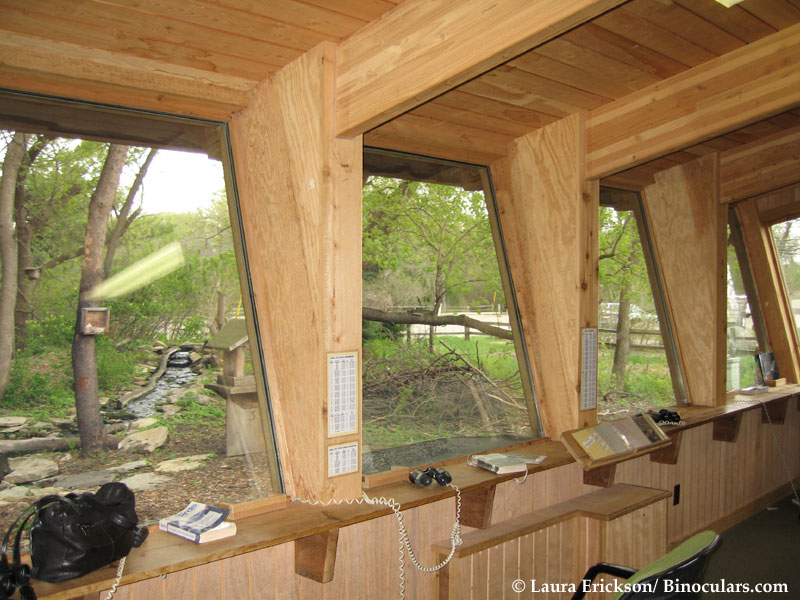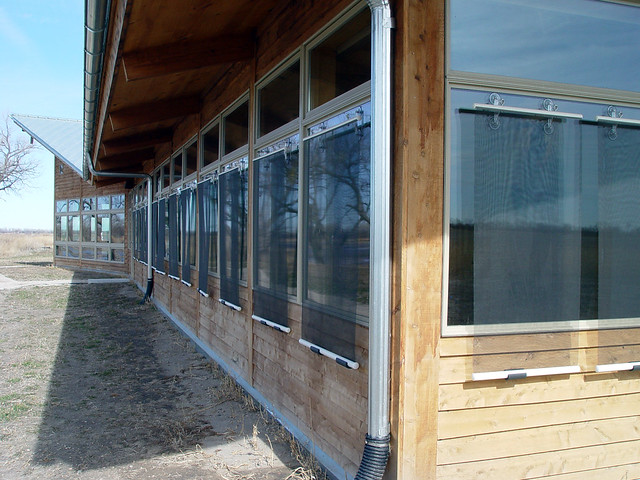6. Make your windows safer for birds.

THINGS YOU CAN BUY THAT EFFECTIVELY MAKE YOUR WINDOWS SAFER FOR BIRDS
- Acopian Birdsavers
- Stickers or tape on your window BUT these must go on the outside, and must be spaced pretty close–birds shy away from obstructions that are less than 4 inches apart horizontally or less than 2 inches apart vertically. That’s a lot of stickers!
Paracord Acopian Bird Savers (also called Zen Wind Curtains) have been tested by Dr. Daniel Klem, who showed they are very effective at preventing window collisions. They’re attractive, inexpensive, and don’t detract from the view, too. I interviewed Jeff Acopian about his invention, and have photos of windows with BirdSavers, on my blog here.
The American Bird Conservancy’s tips for reducing window strikes..
The Cornell Lab of Ornithology’s tips for reducing window strikes.
People have known that windows can kill birds since at least 1832; that’s the earliest published account I could find of a bird hitting a window in North America, written by Thomas Nuttall in A Manual of the Ornithology of the United States and of Canada. He described a Sharp-shinned Hawk that, while pursuing prey, flew through two panes of greenhouse glass and was killed by a third. Most home owners have had at least one experience with a bird kill at a window, and for decades, various ornithological museums have been adding window-killed specimens to their bird collections. In fact, more birds are killed each year from striking windows than from any other direct cause of death, and the problem is growing as window sizes increase and houses get larger.
When a bird strikes a window, sometimes it flies off immediately or shortly thereafter, but many of these injured birds have fractured their beaks, suffered hairline skull fractures, or developed hematomas or other serious injuries that will kill them within hours or days.

Birds that hit windows are often picked up by predators that have learned to associate the familiar “thud” with an easy meal. In 2004 I was sitting at a window when a Yellow-rumped Warbler struck it; within two seconds a Blue Jay flew in and picked up the stunned little bird. Research indicates that at least half of all birds that hit windows end up dying, either directly from trauma, from predation or accidents that occur while the bird is stunned, or later from internal injuries. When I was rehabilitating wild birds, several people brought me woodpeckers that they thought were going to be fine because the birds seemed alert and could move their wings, but on examination, I discovered that they were paralyzed, incapable of any controlled movement whatsoever; these birds always died.
Window strikes may happen only once or twice a year at some windows, while other windows may kill hundreds of birds annually, particularly during migration or when birds are concentrated at feeding stations. Multiply this by all the windows in America, and the problem becomes staggering, especially as average house and window sizes increase. Dr. Daniel Klem Jr., an ornithologist at Muhlenberg College, states, “Glass is ubiquitous and it’s indiscriminate, killing the fit and the unfit.” After decades of research, Klem estimated that collisions with glass kill 100 million to 1 billion birds in the United States every year; he believes that the upper limit of this estimate is conservative and that only habitat destruction is responsible for the loss of more birds.

Until Klem started researching the magnitude of the problem, ornithologists and conservationists focused on other issues that were considered more important to bird conservation. Now, as researchers gather more data about the extent of this problem and search for viable solutions, perhaps we can envision a day when all new windows will be made from more bird-safe technologies.
Klem has been researching different ways of manufacturing glass to make it more visible to birds. Glass etched with closely spaced dots or other patterns may help birds see it without detracting from a window’s aesthetic qualities. Angling windows downward, so that they reflect ground rather than sky, can help, but it’s difficult and expensive to change already constructed windows, and no windows currently manufactured have casings designed for this.

But Klem seems hopeful: “The heart of this is to get a piece of glass that will solve this problem. We can’t say that we have that yet. But I’m more encouraged than ever that we can come up with a solution that will stop this senseless slaughter of wildlife.” Developing bird-safe glass will take time and money, and only when consumers start demanding it will manufacturers go to the trouble of funding studies and changing their manufacturing practices.
Meanwhile, while we wait for more permanent solutions, we have to figure out how to minimize the death toll at our own windows. The windows on single-family dwellings kill mainly feeder visitors, other resident backyard birds, and, during migration, Ovenbirds, cuckoos, and other low-flying migrants that are passing through. Whether the glass is clear or reflective, birds simply don’t see it.
Klem discovered that the distance between feeders and a window is directly related to the number of feeder birds killed at that window. Feeders placed directly on the window glass or within three feet of it are significantly safer than than those placed farther away. Birds at window feeders are more likely to see the glass, and even if they don’t, when they take off from a window feeder thay aren’t going at top speed for at least a few wing beats. When feeders are farther away but still close enough to the windows for us to enjoy watching the birds (within about thirty feet), window kills are inevitable.

Besides placing feeders right outside windows, what else can we do to reduce or eliminate kills?
Absorb the impact. Put something outside the window glass that will absorb the impact when birds do hit it. A window screen or netting works very well if it’s set three or four inches from the glass and is taut enough to actually “catch” a bird and bounce it off, like a trampoline, before the bird reaches the glass.

Make the glass more visible. The following things can help birds see windows (listed roughly from most to least effective):
- One-way transparent film that permits people on the inside to see out but appears opaque on the outside. The best product currently available is CollidEscape, marketed by Large Format Digital. This prevents birds from both colliding into the glass and fighting their reflections. Part of the purchase price supports the Fatal Light Awareness Program.
- BirdSavers, a.k.a. Zen Wind Curtains. These are aesthetically pleasing, inexpensive, and proven effective. *Vertical exterior tape strips, set no more than four inches apart on the glass.
- External shutters that are kept closed when you’re not taking advantage of the light or the view.
- External sun shades or awnings, to reduce reflections of the sun or sky.
- Windows angled downward. This is possible only on houses under construction or when putting in new windows, but kills are reduced when the glass reflects the ground rather than the sky and trees.
- Interior vertical blinds with the slats half open.
- Soap on the outside of the window.
- Decals, sun catchers, Mylar strips, or other objects on the outer surface of the glass. These should be set close enough that an open adult handprint can’t fit between them.
During migration, and particularly on foggy nights, when nocturnal migrants are disoriented, birds are drawn to lights on tall buildings jutting into their migration pathway. Once in the lighted area, they mill about, striking one another, the windows, or the building itself. Volunteers for the Fatal Light Awareness Program (the pioneering organization with regard to this issue), Lights Out Chicago, and other groups monitor kills at lighted high-rise buildings. These organizations provide educational programs to encourage owners and residents of tall buildings to turn off unnecessary lights and close drapes or blinds at night, especially during migration, to minimize the death rate. Research by Dr. Robert DeCandido and Deborah Allen is currently being done at the Empire State Building in New York to evaluate bird collision patterns in the vicinity of large lighted buildings to that these structures, romantically called “the nearest thing to heaven,” stop dispatching birds to heaven before their time.

THINGS YOU CAN BUY TO HELP MAKE YOUR WINDOWS SAFER FOR BIRDS
- CollidEscape products to make your window less reflective, including American Bird Conservancy: ABC Bird Tape
- Acopian Birdsavers
From 101 Ways to Help Birds, published by Stackpole in 2006. Please consider buying the book to show that there is a market for bird conservation books. (Photos, links, and updated information at the end of some entries are not from the book.)
